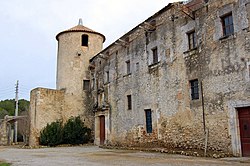Parc del Foix is in Barcelona (province) of Spain. It has a small lake (panta del Foix) and is crossed by the river Foix.
Understand
[edit]The park is located in the continuation of the Garraf massif and the position of the reservoir is determined by the Foix river basin, as it is in the last section of that basin. The reservoir was inaugurated in 1928 and is located in the municipality of Castellet i la Gornal.
Tourist office
[edit]- 1 Main tourist office (Oficina del Parc del Foix), C/ Castell, 31, 08729 Castellet i la Gornal, ☏ +34 977 670 169. Sa-Th 10:00-14:00.



- 2 Parc del Foix documentation centre (Centre de Documentació del Parc del Foix), Biblioteca de Santa Margarida i els Monjos, Cadí, 2, 08730 Santa Margarida i els Monjos, ☏ +34 938 186 705, [email protected].



History
[edit]Foix has played a prominent role as a crossroads of civilizations. In Ibero-Roman times it crossed the road from Tarraco to Bàrcino, and in the Middle Ages it became a border between Christians and Muslims. The Penyafort Castle and the Castellet Castle date from this period, which had great strategic value. More recently, numerous farmhouses bear witness to a time when the Mediterranean trilogy (oil, wheat and vines) presided over the agriculture of the area. On the other hand, the cañades, or ancient transhumance paths, show the importance that livestock farming had.
Flora and fauna
[edit]The Foix Park presents well-differentiated ecological environments. The holm oak forest grows, very localized and often mixed with pines, in the shadiest and humidest areas, while the white pine forests dominate in the driest and sunniest places. In these environments we can find the margallo and other shrubs such as the mastic, the garric, the arbocer, the aladern, the boxwood, the heather, the steppe, and aromatic plants such as rosemary or thyme.
The great variety of environments in the Foix Park is home to a great variety of fauna. The quality of the water is fundamental for the life of the plants and animals that will be the food of many species of birds.
In the wooded areas there live mammals such as the badger, the genet, the fox, the wild boar and birds such as the kestrel, the jay, the blue tit and the tudó, while in the rocky areas we can find some reptiles such as the lizard, the white snake and the green snake, and some birds of prey such as the Bonelli's eagle. The caves are home to various cave animals, such as some species of bats, and in the humid environments, there are owls in abundance.
Climate
[edit]Get in
[edit]By train
[edit]- 1 Els Monjos station, Carrer de l'Estació, Santa Margarida i els Monjos. RENFE - Rodalies C4. Manresa-Sant Vicenç de Calders
By car
[edit]Motorway: AP-7.
Roads: N-340, BV-2115, BV-2116, BV-2117.
Fees and permits
[edit]It is free to enter.
Get around
[edit]Parking
[edit]- 2 Parking castellet picnic area (Parking Àrea d’esplai de Castellet), Camí del Cementiri.



- 3 Castellet parking (Aparcament de Castellet), BV-2115.



- 4 Parking Pared de la Talaia, BV-2115.



- 5 Parking BV-2115, BV-2115.



- 6 Parking Torrelletes, Carrer de Santa Magdalena, Torrelletes.



See
[edit]
- 1 Castellet castle (Castell de Castellet), Carrer del Castell, 36, ☏ +34 93 814 45 06. Guided tours are held on Saturday and Sunday the second weekend of each month: from 10:00 to 14:00. Visits must be arranged in advance. Built on top of a hill next to a meander of the Foix River, at the Foix reservoir. Remarkable set of round and square towers with high defense walls. Result of the "restoration" carried out from 1928. It has medieval elements (11th and 12th centuries) with other Gothic and many invented parts. It also has Romanesque and Gothic windows and crowning battlements. It forms a fanciful set.




- 2 Penyafort castle (Castell de Penyafort), Camí del Castell de Penyafort, ☏ +34 669 28 75 39, [email protected]. Guided tours: every Sunday at 10:30 and 12:00 with prior reservation. It is a complex formed by the remains of the old fortified manor house of Penyafort (circular tower, wall panels), a convent and a church. It is believed to be the birthplace of Saint Ramon de Penyafort (1185-1275), Dominican and canonist, doctor of jurisprudence from Bologna and advisor to James I, canonized in 1601. This space, with different architectural stages, is the gateway to the Foix Natural Park.



Do
[edit]Hiking
[edit]- local hikes
- From castle to castle: from Penyafort to Castellet, 7 km, 163 m total climb.
- SL-C 91 La font d'Horta, 4 km , 137 m total climb.
- Long Range
- GR92 crosses the park
Birdwatching
[edit]- 1 Cal Bladet Birdwatching point (Observatori d’aus de Cal Bladet). Access via the Font d'Horta route.Free-use observatory. It has two levels, the lower one with spyglass. free.



- 2 Omeda Birdwatching point (Observatori d’aus de l’Omeda). A scientific observatory; to use it, you must request the key from the Foix Park Office.



Buy
[edit]Eat
[edit]Picnic
[edit]- 1 Castellet picnic area (Àrea d’esplai de Castellet), Camí del Cementiri, Castellet i la Gornal.



Drink
[edit]Sleep
[edit]Look for lodging in nearby towns Vilanova i la Geltrú and in Vilafranca del Penedès

